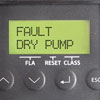Ground water systems, such as wells that feed irrigation, households, livestock, mining and thermoelectric applications, account more than a quarter of the United States’ fresh water usage daily. More than half of water used for irrigation is ground. Many wells are located in remote areas where they are notoriously prone to exhibiting reliability problems due to glitches in the power supply. Since drillers often supply the pumps and pump motor controls for these wells, any factors that impact the reliability of pumping systems are issues that can affect drillers’ abilities to offer excellent service to their customers, and make money.
Interruptions in power cause system shutdowns, which can have varying detrimental effects, depending on the system. Traditional motor starters used with pumping systems contain trip sensors that react based on the flow of current to the motor. They are prone to unnecessary tripping when the motor system could well have continued running without damage to the motor or other components. Traditional starters also provide no protection against pump motor damage from power-quality problems such as under- or over-voltage. The harsh environments that well pumps inhabit, combined with wavering or intermittent power, combine for deadly motor conditions. Add in frustrated owners or service personnel who disable the current monitors on pumps that are constantly tripping, and you have a prescription for frequent and costly motor replacements.
When a pump motor trips, someone must deal with the situation, no matter how remote, what time of day, or what the weather. If the pump is covered by a manufacturer’s warranty, personnel from the pump company may be the designated first responders, even though the problem may have nothing to do with the pump. But, regardless of who must deal with the problem, unnecessary motor trips certainly are inconvenient and costly. A solution to the problem of nuisance tripping is to use pump starters that have been designed to monitor power consumed by the motor rather than current.

Figure 1.
Power monitoring doesn’t eliminate all nuisance trips, but it can protect pump motors from the effects of voltage lags or spikes and overpower (runout) or underpower (dry pump or deadhead) conditions that can kill motors. Such problems might be missed by solely measuring current.
Alex Estrada with Miami Pump and Supply Co. (Miami, Fla.) has standardized his business, primarily using intelligent pump starters because of the increased protection and reduced tripping that they provide. “Bottom line is I don’t get callbacks after the panel is installed,” he says. I ship a lot of products out of the country, and my customers need an easy-to-set-up product that requires minimal support because the direct supplier – me – isn’t available to visit the project site. I don’t just use intelligent pump starters for deep well submersible applications, I use them for HVAC, water transfer, water conditioning, domestic recirculation and any other pump applications we work on.”
Another situation that can cause added expense for pump operators occurs when maintenance or repair personnel are not able to easily determine why a pumping system has stopped working. If the technician had a verifiable way to pinpoint the date and time of the failure, it would be easier to diagnose whether the interruption was due to hardware failure or power loss (or surge), or whether there’s an entirely different problem, such as a dry pump condition. If the cause of the failure had nothing to do with the pump in the first place, then getting detailed information on the failure may save a wasted service call by the pump manufacturer.
Because of this, pump- and current-monitoring device manufacturers have been known to advise their customers to switch off the overheat protection feature on their devices in order to reduce nuisance trips. This practice also has been widely adopted by service personnel as a solution to problematic installations. It goes without saying that it is self-defeating to have a protection device turned off.

Figure 2.
Mat Player of Delco Western, a Salt Lake City ground water pump dealer and installer, prefers to use intelligent pump starters because of the versatility for use in different applications or, as he calls it, plug-and-play functionality. “I stock [intelligent pump starters] because I don’t need to pick coils for each starter, I can send a 24VAC signal from a timer for an irrigation system or 120VAC from a sensor for a residential water supply because they have integral relays,” says Player. “They also have multi-tap transformers, so I can use the same panel for a 10-HP at 208V as a 20-HP, 460V motor. I just have to change one wire.”
Intelligent pump starters that monitor power for motor protection deliver the added benefit of kWH or power consumption metering. With kWH metering, power costs can be monitored and allocated, which can contribute to more accurate cost analysis for the system to which the pump is attached. For example, it would be possible to attach a cost to a well pump used exclusively for a specific crop. The real-time and total consumption over time can be seen on the pump starter’s operator screen. The possibility of remote monitoring and logging power usage reduces the time and cost associated with physically checking remote pumps.
With energy, installation and service costs spiraling upward, the demand for monitoring power to protect motors and analyze energy efficiency will only increase. As more manufacturers of intelligent pump starters emerge, drillers and pump providers should be looking to use these smarter starters, or they will miss an opportunity to offer customers the best value available to protect and utilize the pumps in their ground water systems.
ND
Brad Hubbard is with Cerus Industrial Inc., Hillsboro, Ore.
Report Abusive Comment